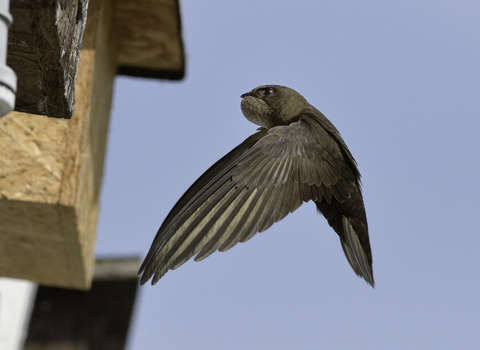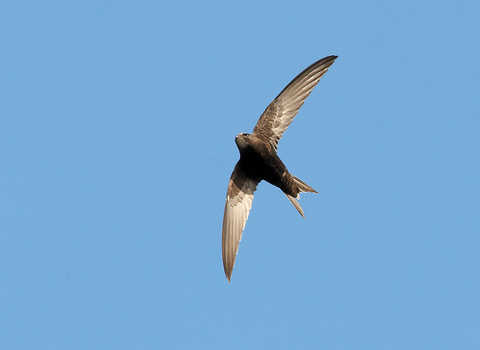
A swift flying to a nest box attached to the eaves of a cottage with its throat pouch bulging with insects it has caught to feed its chicks - by Nick Upton

Swift ©David Tipling/2020VISION

©Stefan Johansson

Nick Upton
Swift
Scientific name
Apus apusWhen to see
Swifts arrive in the UK from April onwards. They then leave in August.Species information
Statistics
Length: 16-17cmWingspan: 45cm
Weight: 44g
Average lifespan: 9 years
About
Swifts spend most of their lives soaring high in the sky, only ever landing to nest. They are easy to spot as they look like an arrow whirling through the sky, and often fly in groups. Originally, they would have nested in trees or cliffs but now prefer the roofs of old buildings like churches. Swifts spend the winter in Africa but travel to Britain every year in April and May.They feast on small flying insects by catching them in flight. Insects collect in a special pouch at the back of the swift's throat, where they are bound together by saliva until they form a kind of pellet known as a bolus, which can be regurgitated and fed to chicks. One single bolus can contain over 300 insects, with some holding over 1,000!
How to identify
The swift is black all over, with a small, pale patch on its throat. Looking a bit like a boomerang when in the air, it is very sociable and can often be spotted in groups wheeling over roofs and calling to each other with high-pitched screams. It is larger than swallows and martins (which have white undersides) and, unlike them, does not perch on wires, buildings or trees.Distribution
A common and widespread summer visitor.In our area
How to help swifts where you live
Swifts are on the UK Red List, having suffered serious declines in recent decades. It's estimated that almost 60% of UK swifts have disappeared over the last 25 years. There are many ways you can help look after swifts in your local area.
Did you know?
Swifts spend almost all of their lives on the wing, even sleeping, drinking and mating while flying; they only land to nest.Watch
Swifts (https://vimeo.com/453689992)
Swifts by Tom Hibbert
How to help swifts where you live
Swifts are on the UK Red List, having suffered serious declines in recent decades. It's estimated that almost 60% of UK swifts have disappeared over the last 25 years. There are many ways you can help look after swifts in your local area.
